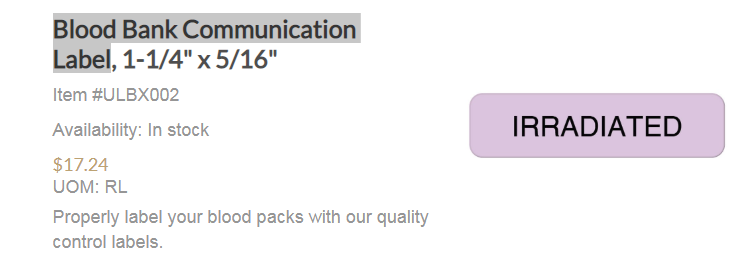
Pmanager
Content Type
Store
Profiles
Forums
Blogs
Events
Frequently Asked Questions
Gallery
Downloads
Glossary
Links Directory
Questions
Jobs
Vendors
Posts posted by Pmanager
-
-
By any chance, do you know where you place that label at on the ISBT label.
-
Hello. I work for a large blood bank in Houston. We do a considerable amount of irradiations daily. In an effort to improve our processes I found this label ---->> https://www.unitedadlabel.com/blood-bank-communication-label-1-1-4-x-5-104 .
Does anyone who receives and/or irradiates blood components affix this type of label onto their units? Apparently, this label is non-ISBT compliant and the label is designed to only go onto the base label of the product.
I am open to suggestions.
Thanks,
-
4 units or 1% percent whichever is greater. Our center does 400 units in two days or about 4000 a month at the most. We usually submit 3 to 5 units a week for QC.
-
I used the TC-3 model from Hampshire Controls Corp. Their literature also states 2 +/-. But I found that the equipment was within 1 +/- during my validation. This was compared to a Liquid in glass and Digital thermometer. You can always purchase the item and do your validation within the 30 days of receipt of purchase. If you dont like it, just send it back. I already had my validation and test cases set up before I purchased the equipment and it took 3 hours to do the validation. :cool::cool::cool::cool::cool:

-
We've had this for about 2 years and like it a lot. There was no manufacturer requirement for daily QC, so I'm not sure why daily QC would be performed. We don't QC our other thermometers every day.
I have a TempCheck and we also do not perform a daily QC.
During my validation of the thermometer I found the TC to be within 1 degree of the NIST Liquid in Glass temperature around 90 percent of the time and the rest was exactly the same temperature.
Their own annual calibration instructions even state that the NIST thermometer and the TempCheck must be the exact temperature during the procedure.
So I assuming they are just giving themselves breathing room.
-
We have been doing irradiation for many years and are inspected by FDA, with no problems as to use of the indicators. My inderstanding is that these are used as QC indicators for the batch and do not actually "measure" the specific amount of irradiation delivered--but rather show that the batch was actually exposed to radiation. The dosimetry which is periodically required (annually for CS137) measures the dose delivered to various parts of the canister and ensures the 2500 Gy at midpoint and 1500 Gy overall.
Indeed this is true.
-
If they were real, it could range from a couple of hours to a couple of days if using the CS-137. It maybe a little sooner if the IRR uses a Cobalt 60 source. But since most of these machines have 12 to 24 inches of lead, I cant imagine how such leak would go unnoticed . In others words, I think the employee was exaggerating their symptoms.
-
I wouldn't recommend an IR gun. I piloted and tried to validate the gun for blood products and the degree of difficulty is what made me cancel the validation. When you use the gun, you have to take into account of a few things for an accurate temperature reading. Emissivity, the type of material of the bag, the texture of the bag, the distance from what you are sampling, making sure the gun has adjustable emissivity settings, the angle of the bag when sampling, the brightness of the light in the room, is the bag shiny or not. And no I am not making this up. I ended up getting something called a TC -3 TempCheck. It is designed for blood bags and its a pleasure to use as well.
-
We use Fenwal strippers and we process over 375,000 units a year... Sarstedt products are never going to be on my list for purchases ever again.
-
If performing multiple SCD welds, does one need to document each visual inspection of each weld, or can there be a blanket statement that, "All welds acceptable"?
The blanket statement should be acceptable. We place the final check on the pooled product itself.

Irradiate label affixed to the ISBT label
in Transfusion Services
Posted
Do you have a product label i could reference for my facility. The one label I found, states "For base label use" only. thanks for your help